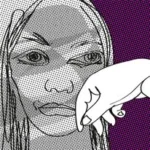Samurette @ Women House
Samurette's Portrait Gallery of the Association of Revenge Friends @ Women House Amsterdam | NDSM FUSE | 16-5 t/m 6-7-2025


Womanhouse (1972) & Women House (’24 -’25).
Women House Amsterdam, 16 May to 6 July 2025, NDSM FUSE, Amsterdam.
NDSM XPO XVII WOMEN HOUSE AMSTERDAM will reflect on the status of women in the arts in the 21st century by revisiting and highlighting the issues that have constrained women’s lives and artistic expressions. It focuses on a persistent paradox in the arts: despite the expansion of feminist discourse and the increasing visibility of women artists, their contributions are often overlooked due to systemic sexism, wich deprives them of institutional recognition and appreciation. It places a particular emphasis on the relationship between art and gender, in relation to the social factors that contribute to the vulnarable position of women. In particular, black women, immigrants, mothers, lesbians, transgender and older women artists, whose proposals are often marginalised in dominant artistic narratives. ndsmfuse
Women House Amsterdam is curated by Uruguayan architect and curator Alejandra Muñoz and Brazilian visual artist and art researcher Neyde Lantyer. They initiated the project in 2024 in Brazil under the name ‘Casa de Mulheres’ at the Museum of Modern Art of Bahia, Mam-ba. The exhibition paid homage to the first feminist exhibition ‘Womanhouse’ from 1972, by artists Judy Chicago and Miriam Shapiro in Los Angeles, USA. In its second edition, the exhibition travels from Salvador da Bahia, in southern Brazil, to Amsterdam with the aim of amplifying intersectional feminist voices in contemporary art discourse and reaffirming the transformative potential of art and feminist practices in rewriting history, creating utopias and envisioning a new future.
Womanhouse was a project by Judy Chicago and Miriam Schapiro.
Womanhouse (January 30 – February 28, 1972) was a feminist art installation and performance space organized by artists Judy Chicago and Miriam Schapiro, co-founders of the California Institute of the Arts (CalArts) Feminist Art Program, and was the first public exhibition of art centered upon female empowerment.
The Feminist Art Program In 1971, Miriam Schapiro and Judy Chicago taught a groundbreaking feminist art class at the California Institute of the Arts in Valencia, USA. Their aim was to radically question the values of the male-dominated art world and to encourage women to make art out of their own experiences and inner lives.
The all-female class transformed an abandoned Hollywood mansion into an environmental art space dubbed “Womanhouse.” In its rooms, they created installations and performances about gender, menstruation, domesticity, and other subjects rarely discussed by women in public.
Judy Chicago (born Judith Sylvia Cohen, July 20, 1939) is considered one of the “first-generation feminist artists”, a group that also includes Mary Beth Edelson, Carolee Schneeman, and Rachel Rosenthal. They were part of the feminist art movement in Europe and the United States in the early 1970s to develop feminist writing and art. She is known for her large collaborative art installation pieces which examine the role of women in history and culture. Her most well-known work is The Dinner Party (1974-79), which is permanently installed in the Elizabeth A. Sackler Center for Feminist Art at the Brooklyn Museum. The Dinner Party celebrates the accomplishments of women throughout history and is widely regarded as the first epic feminist artwork.

Judy Chicago, The Dinner Party, 1974–1979. Ceramic, porcelain, textile; triangular table, 576 x 576 in. (1463 x 1463 cm) each side: 48 ft. (1463.4 cm). Brooklyn Museum, usa. Photo by Donald Woodman.Judy Chicago,
Miriam Schapiro (November 15, 1923 – June 20, 2015) was a Canadian-born artist based in the United States. She was a painter, sculptor, printmaker, and a pioneer of feminist art. She was also considered a leader of the Pattern and Decoration art movement. Schapiro’s artwork blurs the line between fine art and craft. She incorporated craft elements into her paintings due to their association with women and femininity. She often used icons that are associated with women, such as hearts, floral decorations, geometric patterns, and the color pink.
Schapiro’s art piece called Dollhouse was shown at the Womanhouse exhibition. The piece playfully subverts the saying, “A woman’s place is in the home”. Womanhouse was a watershed in feminist art, attracting thousands of visitors. It was also a transformative experience for Schapiro, who subsequently dedicated her work to celebrating female experience and feminine crafts. “I was trained to be an artist by men,” she said, “but I learned how to express myself from women.”

Miriam Shapiro, Dollhouse 1972, wood and mixed media, overall: 79 ¾ x 82x 8 ½ in. (202,6 x 208,3 x21,6 cm.), Smithsonian American Art Museum, usa.
RELATED NEWS – CONTEXT
Samurette’s Portrait Gallery NDSM Women House
Samurette, takes, —together with 24 other feministe artists from 10 countries— part in the Amsterdam art exhibition: NDSM XPO XVII—WOMEN HOUSE AMSTERDAM! Curated by: Alejandra Mûnoz (UY/BR) & Neyde Lantyer […]
Samurette’s Revenge Friends
Detracto erroribus et mea. Malorum temporibus vix ex. Ius ad iudico labores dissentiunt.






